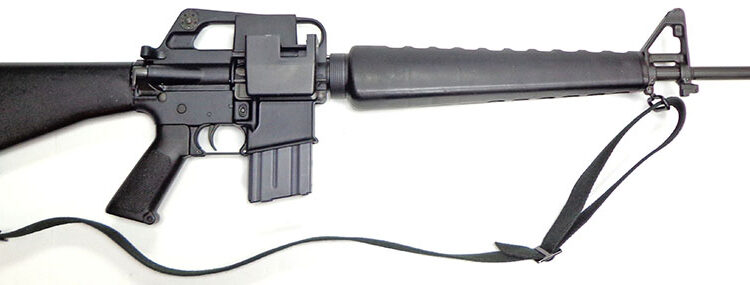By Christopher R. Bartocci
It seems like the calibers available for the AR-type rifle are endless. With ammo shortages, standard 5.56mm can be $1 or more per round and the special calibers the same if not more (6.8mm Rem SPC, 300 Blackout, etc.). The .22 Long Rifle (5.6x15R) caliber has been the most popular practice and hunting cartridge in the country for more than a century after its release by J. Stevens Arm & Tool Company in 1887. The origins of the .22 Long Rifle come from the .22 Long or the Flobert BB Cap of 1845 through the .22 Smith & Wesson cartridge of 1857 and was developed by J. Stevens Arms & Tool Company in 1887 by combining the cartridge case of the of the .22 Long 40 grain lead projectile of the .22 Extra Long. The .22 rimfire family of cartridges include the .22 CB Short (no propellant), .22 Short, .22 Long, .22 Long Rifle and .22 Win Magnum. The projectile is the same diameter as the cartridge case and has a heel that fits into the mouth of the cartridge case. Unlike a centerfire cartridge, which has a separate primer or cap inserted into the base of the cartridge case, the entire rim of this family of weapons is the cap, thus the term rimfire. The rimfire cartridge cases are not reloadable.
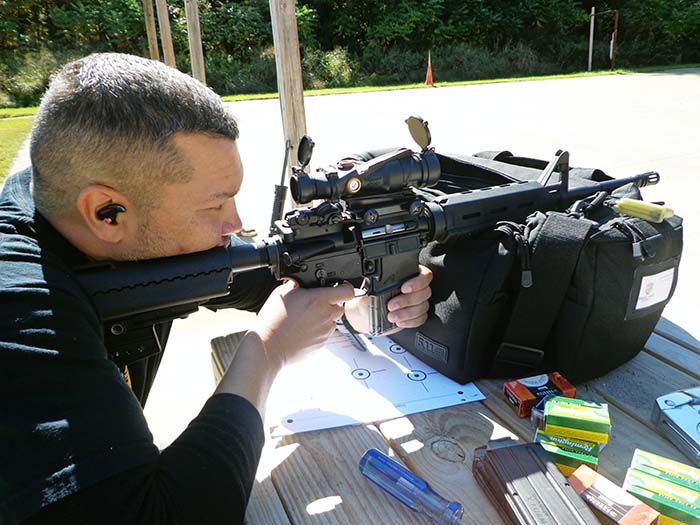
The .22 LR is ideal for the recreational target shooter, small game hunter or as a low cost training alternative for shooters of every discipline from competitive shooting to law enforcement and military training applications. It is very cost effective as the cartridge is very inexpensive and the noise level is very low. There is no recoil whether it is in a revolver, bolt action or semiautomatic rifle or pistol. Projectile weights range from 20 to 60 grains and are available in lead round nose, lead round nose hollow points, copper plated round nose and hollow points and even bird shot loads for unwanted reptiles. Velocities can range from 575 to 1,750 feet per second. The subsonic ammunition is very popular with those who like to use sound suppressors. In fact, .22 LR is used by various militaries throughout the world with suppressors for silent sentry incapacitation. Most states within the U.S. permit sound suppressors (a regulated NFA item) and are fairly common. Ammunition is often bought in 50 round boxes or 500 round bricks. In the U.S., Federal, Winchester, Remington and CCI have complete lines of .22 LR ammunition. This includes low cost plinking ammunition (CCI Mini Mag, Remington Thunder Bolt, CCI Blazer, Win Super X), hunting ammunition (Remington Yellow Jacket, Remington Viper, Federal Game Shok, CCI Mini Mag HP, CCI Stinger, ATI Scorpion, Winchester Wild Cat, Winchester M-22 and match ammunition such as Federal Gold Medal and Remington match/standard velocity loads. There is an abundance of foreign ammunition as well including Wolf, Aguila, PMC and Fiocchi to name just a few.
This 2-part article tests several of the most popular conversions for accuracy and reliability. Part 1 looks at the history and development of the .22 Long Rifle cartridge and its variations as we then jump into the first conversion used for the black rifle: the M261 drop in conversion bolt carrier group and magazine and a current production WMD drop in conversion bolt. Then we go on to look at the Tactical Solutions AR-22 upper receiver conversion and CMMG upper receiver conversion. Part 2 will look at the Black Dog Machine magazines, which actually came with several of the upper receiver conversions. We will look at the DPMS, Spikes Tactical, Chiappa the CORE Rifle systems .22 conversion and discuss some ammunition variations.
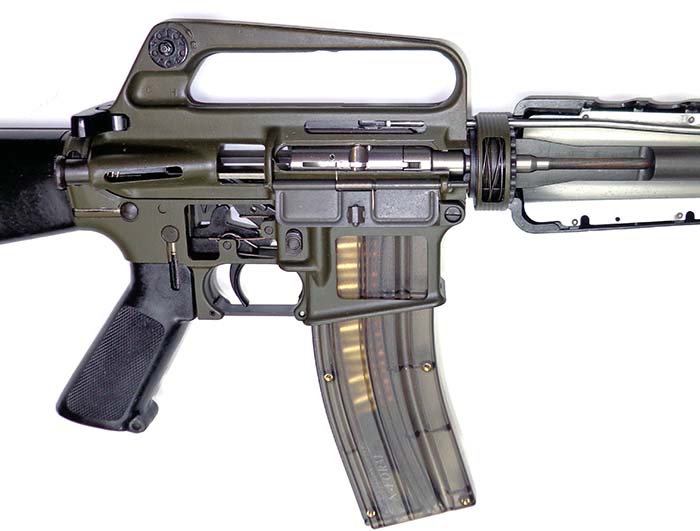
Enter the M261 .22 LR Conversion for the M16
In the late 1970s, the army was looking for a way to keep their soldiers proficient in marksmanship, particularly the National Guard and Reserves. Many of the Guard and Reserve units did not have access to rifle ranges. Though many had access to indoor ranges and private clubs, the back stop would not take the penetration power of the 5.56mm round. However a .22 Long Rifle round was not an issue. Being the bore was similar they developed a drop-in bolt carrier conversion that would convert it to fire the round. Of course a special magazine was needed to feed the rimfire cartridge. The front portion of the conversion unit was basically a 5.56mm cartridge case; the chamber was an inch or so behind the base of the cartridge case. The bolt is blowback operated. The bolt slides on two rails with a recoil spring the goes from the bolt to the endplate on the back of the conversion unit. The buffer/action spring of the rifle is not used. The feed ramp is located on the chamber block. The ejector is built into the left rail. The charging handle grips in the same fashion to the front of the conversion as it does to its standard bolt carrier. The military bolt was designated the M261.

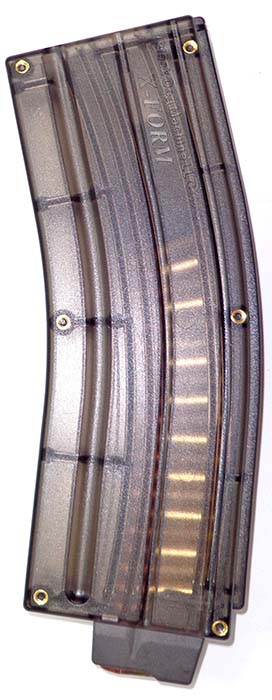
When the trigger is pulled, the hammer strikes the firing pin in turn striking the rim detonating the base. The powder is ignited and expansion of the gas pushes the bullet from the cartridge case through the conversion end approximately 1 1/4 inches and then enters the bore and engages the rifling. The mass of the bolt and the hammer spring keep the bolt closed until sufficient pressure drops and allows the bolt to move to the rear while the extractor draws the cartridge case out of the chamber and the ejector strikes the left side of the cartridge case throwing it out of the receiver. When the bolt reaches it most rearward position the recoil spring drives the bolt forward stripping a round off of the magazine, into the feed ramp, up into the chamber and the bolt closes ready for the next shot. The bolt does not hold open on the last round with this conversion. In all, the .22 Long Rifle is not as reliable of a cartridge as a military grade battle cartridge. The conversion did see malfunctions and was not known to be the most reliable mechanism but it did serve its purpose. One of the biggest problems was a ring of lead that would prevent the bolt from fully closing causing the round to fire out of battery. Also bulged cartridge case caused by bolt bounce but the cartridge would still detonate. Nevertheless, it allowed those who did not have access to a proper rifle range the ability to practice at the ranges they did have access to. Using the smaller caliber, the soldier still had to use and apply the fundamentals of marksmanship that could be carried over to the full power round when the time came. Another issue that would come up with the kit was the rifling pitch. The standard .22 Long Rifle barrel has a rifling twist 1/16 inches. The original M16/M16A1 rifles used a 1/12 inch twist over stabilizing the projectile. Also available was a clip on brass catcher that attached to the carrying handle and receiver.
One of these M261 drop-in units was provided by John Miller for testing for this article. The M261 was dropped into an M16A1 rifle and the brass catcher clipped on. The magazine for the conversion kit fit right into a 20- or 30-round magazine. One was placed in a 20 round magazine. There were 100 rounds of ATI Scorpion ammunition fired through the conversion with no malfunctions. Then 10 rounds of CCI Stingers were tested. There were two malfunctions with the failure of the bolt to fully close.
The M261 has been very heavily updated. The Atchisson-style bolt conversion is sold today by many different manufacturers. The bolt rides on two rails and the bolt is better made and there is a much improved stronger extractor. The drop-in bolt carrier conversion tested is manufactured by WMD Guns and called “Little Beast.” The most noted improvement of the WMD version is the complete system is NiB-X coated. This is a nickel boron type coating that reduces the need for oil and cleans up easily. This unit was placed in a M16A1 rifle. Black Dog Machine magazines were used to test this drop-in unit. This bolt ate up CCI MiniMag, CCI Stingers, Scorpion and Remington Thunder Bolt. However, it did not cycle reliably the Federal Match or the Remington Golden bullets. The rifle was shot with iron sights at 25 yards with all groups being just over 1 inch. When the bolt group was cleaned it should be noted that it was basically wiped off with a rag.
In the late 80s to early 1990s, Colt introduced their own drop-in .22 Long Rifle bolt. This was another form of the Atchisson style but modified with a spring loaded plunger in the rear of the group. When the bolt came to the rear it would strike the plunger giving additional counter recoil force. This drop in group was sold separately as well as provided with certain models of AR-15A2 and Sporter rifles. One of these was not available to the author for testing.
To get consistency, all dedicated upper receivers were tested on the same lower receiver. The lower receiver is manufactured by Aero Precision with a VLTOR stock assembly. The trigger group is the standard Mil-Spec type trigger with standard hammer, trigger and disconnector springs. This could easily represent a standard receiver anyone would have that would purchase one of these receivers. The same optic was used as well, a Trijicon ACOG 4x20mm. Every upper receiver was tested with the magazine that was received with it. However, Black Dog Machine had sent test and evaluation units of their entire magazine line and they were also used throughout testing.
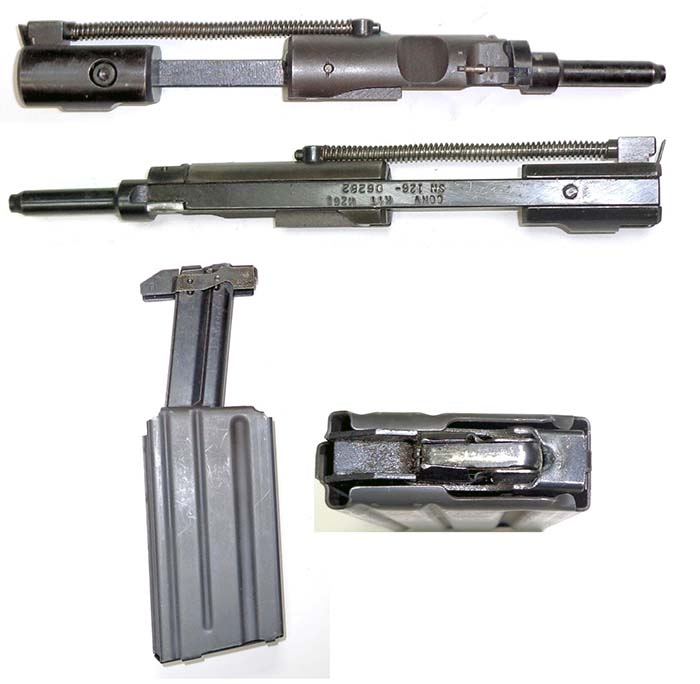
Tactical Solutions (Tac Sol) AR-22 Conversion Upper Receiver
Tactical Solutions is very well known for .22 LR conversion kits and manufactures one of the finest in the industry. They are well known for manufacturing high quality sound suppressers as well as complete match rifles based on the Ruger 10/22. Tac Sol opened their doors in 2002 and was a machine shop specializing in aerospace parts under the name CNC Solutions. The first product they came to market with was their Pac-Lite upper for the Ruger MK and 22/45 series pistols with the barrels for the 10/22 following that. In 2007, Tac Sol introduced their AR-22. Of the components in the AR-22 upper receiver, Tac Sol manufactures the barrel, barrel extension, bolt and guide rail assembly in-house. They offer three variations of complete dedicated .22 LR upper receivers. The first is their AR-22 M4. This is basically identical to the standard M4 carbine upper receiver in fit and feel. It has a military profile 16.1 inch barrel with a “F” marked front sight base. The upper receiver is a Mil-Spec 7075-T6 receiver with forward assist, ejection port cover and fired cartridge case deflector. It comes with standard single heat shield handguards. This upper can be configured in any way you would a standard 5.56mm upper. Another offering is the AR-22 LT, which the upper features a 16.5 inch 6061-T6 lightweight aluminum threaded end barrel with a 4140 button rifled steel liner and a Hogue free float forend. The third model is the AR-22 SB-X. The barrel is a 6061-T6 lightweight aluminum threaded end barrel with a 4140 button rifled steel liner and a Hogue free floating forend. The SBX bore length is 12.25 inches with a permanently attached shroud for an overall length of 16.5 inches allowing the user to attach a suppressor without adding length. The most popular mode sold by Tac Sol is the AR-22 SB-X.
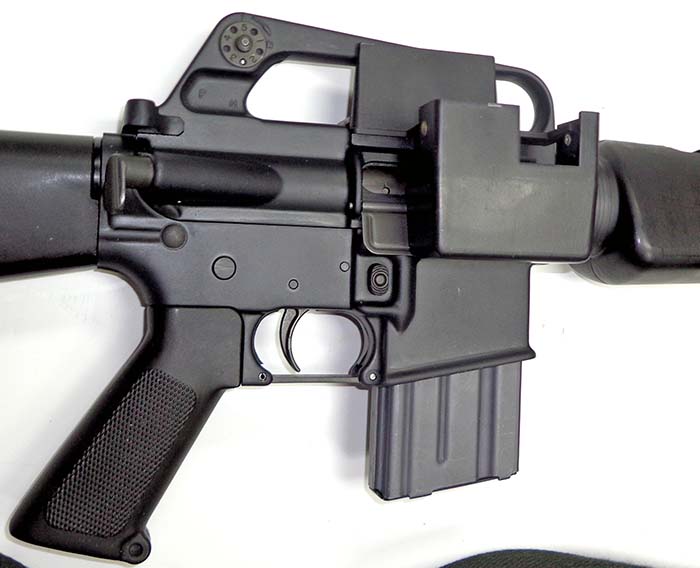
The bolt group is CNC machined from 416 stainless steel and the rails are precision ground tool steel to insure strength, smoothness and reliability. The guide rails are ground flat 0-1 tool steel. The fit and finish is flawless. The recoil spring has a polymer buffer on the rear of the recoil spring to increase service life of the components. With the Tac Sol system being a dedicated .22 LR upper receiver, the feed ramp is on the end of the barrel. The ejector is part of the left guide rail. The bolt group is easily disassembled for cleaning by simply sliding the recoil spring assembly off the left side of the bolt and removing the bolt from the guide assembly. The firing pin is spring loaded to guard against slam fire issues. When the bolt assembly is installed in the upper receiver, there is no gap between the rear of the bolt and the ejection port. The rifle came with one 25-round Black Dog Machine translucent polymer magazine.
The upper receiver tested was their AR-22 M4 model. As received, there were no flaws mechanically of visually seen. The only modification to the upper was the installation of a Magpul MOE carbine length handguard system. This system is far more comfortable to use than the standard GI handguards. The interface between the Aero Precision lower receiver and the Tac Sol upper were excellent with no rattle between receivers. For function testing, 300 rounds of CCI Mini-Mag ammunition as well as 50 rounds of Remington Golden bullets and 50 rounds of Federal American Eagle were fired. Also fired were 50 rounds of CCI Stinger ammunition. No issues were noted at all. However, if the chamber is dirty from firing standard lead ammunition, the longer case of the Stinger might have difficulty chambering. There were no malfunctions at all with this upper receiver conversion group. The full extent of the Black Dog Machine magazines was used including their 10-, 25-, 32-round and their 50-round drum. One magazine stood out; Black Dog Machine developed a billet 25-round magazine that weighs 1 pound. That is the approximate weight of a full 30-round magazine of 5.56mm ammunition. With this magazine in the rifle, it felt exactly like a standard M4 carbine. In fact, if you close the ejection port cover, there is no way you would know it was a .22 LR caliber. The weight and balance were exactly the same. This is excellent for real world training.
Accuracy testing was conducted at 25 yards off of a bench. Group size averaged .700 inches with the best being 3 rounds of Federal Gold Medal at .300 inches: Very respectable. This particular upper was also tested with a sound suppressor.
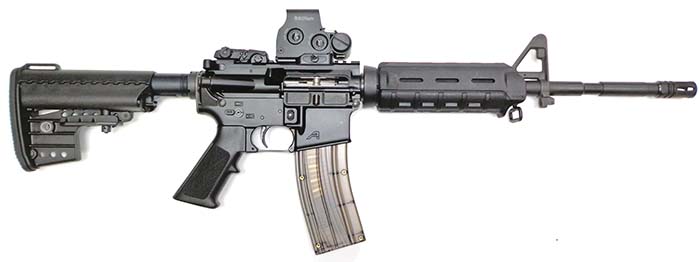
CMMG
Another manufacturer offering a conversion upper receiver is CMMG. CMMG offers a wide selection of not only .22 Long Rifle dedicated receivers but drop-in bolt conversions as well. The upper receiver provided for this article (22B7CA4) was a dedicated .22 LR upper. The receiver is manufactured from 7075T6 aircraft aluminum and has a forward assist although not functional. The upper receiver is a standard M4-type with a Mil-Std 1913 upper rail and a fired cartridge case deflector. Added to this upper receiver is a gas deflector located right in front of the fired cartridge case deflector. The purpose of this is to keep unburnt propellant from hitting the shooter in the face, not to deflect cartridge cases. The barrel has a M4 profile and is 16 inches in length with a 1/16 inch twist. The barrel is manufactured from 4140 chromoly steel. The muzzle device is the standard A2 compensator. The upper was equipped with an 11-inch free float handguard manufactured by CMMG. The quad Mil-Std 1913 handguard was very well made.
The bolt is a modified Atchisson design. The end of the bolt group contains the feed ramp for the round and the end slides over the rear of the barrel. The bolt group is made from stainless steel. The bolt was very well made with little to no machine marks. This bolt may be converted to the drop in Atchisson design by replacing the tip with the one that is the shape of a 5.56mm cartridge case.
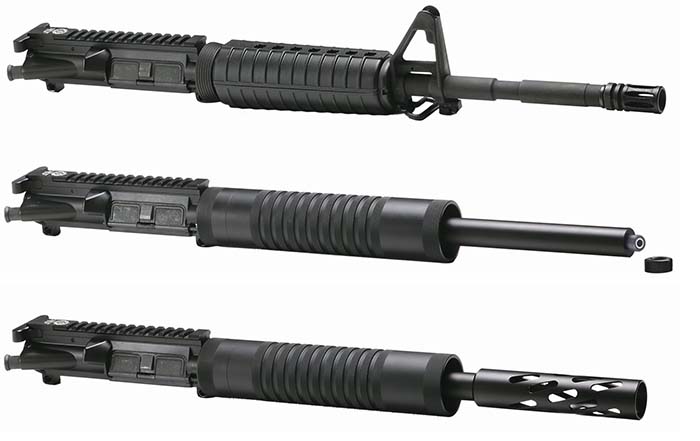
No magazine was provided with this upper receiver. Black Dog Machine magazines were used to test fire the upper. CMMG make their own magazine called the 25R3, this is a next generation magazine, which will hopefully be available in the very near future.
CMMG offers an array of upper conversion styles. This includes standard 20 inch M16A4 style as well as M4 style upper receivers. Also offered is a 16 inch lightweight (pencil) barrel. Both fixed and low profile sights are options. Due to their mounting methods for the barrels, any handguard system that will attach via barrel nut and or handguard cap can be used.
The upper receiver was placed on the Aero Precision lower receiver. The ammunition tested was CCI MiniMag, CCI Stinger and Federal Match. The Federal Match caused several malfunctions due to it not being a high velocity load. However, the groups were excellent. When the rifle was given the CCI MiniMag and Stinger loads, the rifle cycled with no issues. This rifle was shot at 25 yards with the best group being with the malfunctioning Federal Match at just under 1 inch. The others were not much larger. The CMMG is a very high quality dedicated upper receiver. They offer several models with MSRP ranging from $500 to $625.
Coming up in Part 2: a look at modern .22 LR ammunition as well as Black Dog Machine magazine options. Also reports on .22 LR upper conversions from DPMS, CORE15, Spikes Tactical and Chiappa.
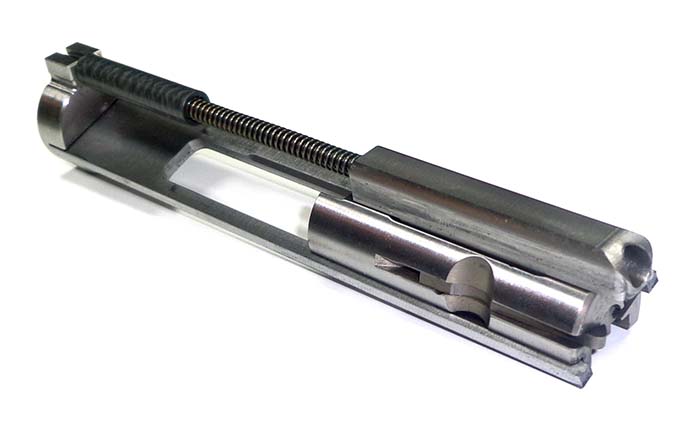
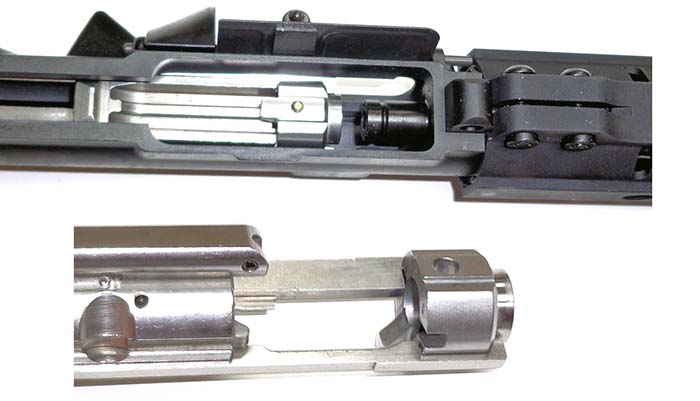


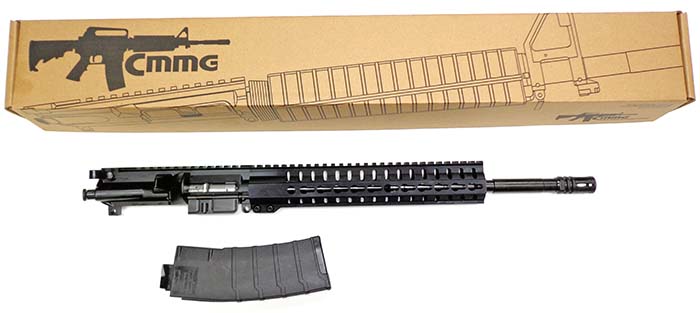
| This article first appeared in Small Arms Review V18N5 (October 2014) |



